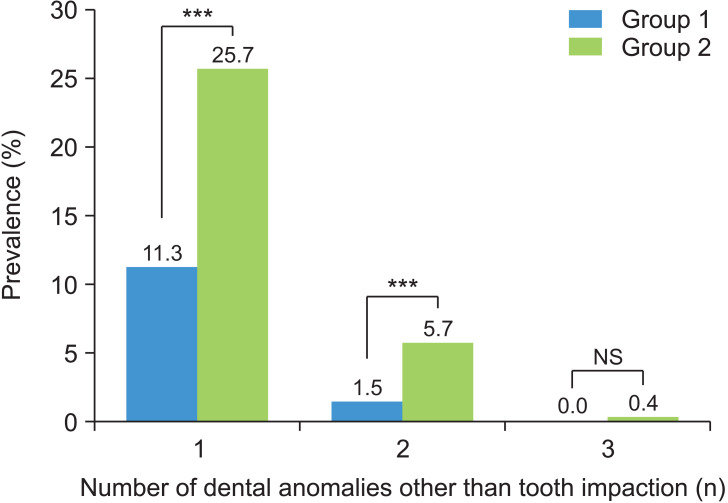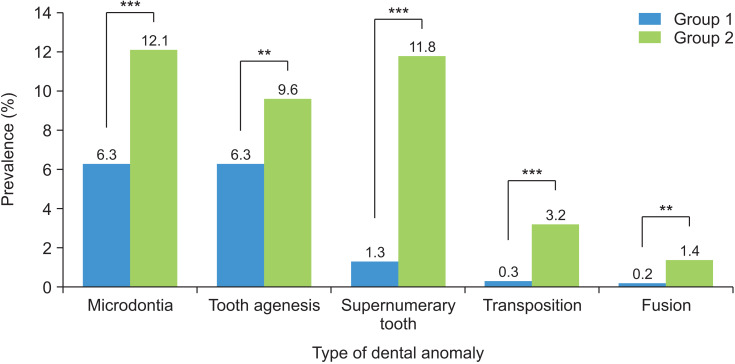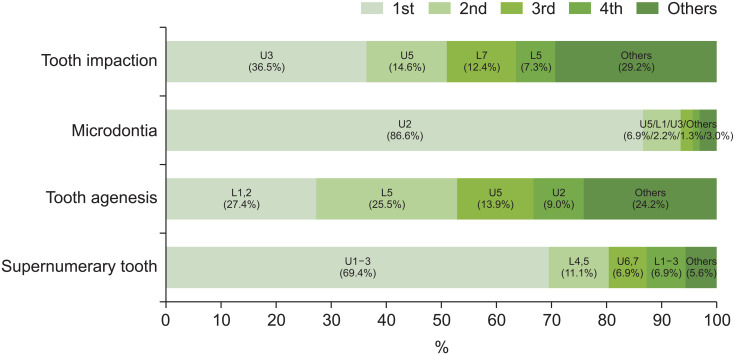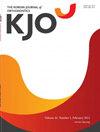韩国正畸患者常见的牙齿异常:最新进展。
IF 1.9
3区 医学
Q1 Dentistry
引用次数: 3
摘要
目的:调查韩国正畸人群牙畸形(DAs)的患病率和类型,比较不同类型错牙合的DAs,探讨牙嵌生与其他DAs的相关性。方法:将3240例正畸患者分为ⅰ类、ⅱ类、ⅲ类错牙合组。通过检查诊断记录,确定常见的牙内嵌、小牙、发育不全、多生牙、转位和融合的存在和位置。将样本分为无嵌塞组1和有嵌塞组2。调查其他DAs并发嵌塞的发生率,并与第1组进行比较。结果:牙内嵌最常见,其次为小牙畸形、牙发育不全和多牙畸形。ⅰ类组与ⅲ类组发病率顺序相同,但ⅱ类组发育不全发生率高于小齿畸形发生率。四种da的患病率在III类组中最低。总体而言,8.6%的患者被分为第2组。第2组非嵌塞性DAs的发生率和多发性并发DAs的患病率明显高于第2组。嵌塞与多牙、移位和融合有显著关系。结论:由于错牙合类型的不同,DAs的患病率和模式也不同。由于阻生牙患者发生其他da的风险较高,因此早期发现阻生牙并详细诊断其他可能的da是必要的。本文章由计算机程序翻译,如有差异,请以英文原文为准。



Common dental anomalies in Korean orthodontic patients: An update.
Objective The aim of this study was 1) to investigate the prevalence and pattern of dental anomalies (DAs), 2) to compare DAs according to the type of malocclusion, and 3) to investigate the correlation between tooth impaction and other DAs in the Korean orthodontic population. Methods A total of 3,240 orthodontic patients were classified as Class I, Class II, or Class III malocclusion groups. The presence and location of common DAs, including impaction, microdontia, agenesis, supernumerary tooth, transposition, and fusion, were identified by examining diagnostic records. Furthermore, samples were classified as Group 1 without impaction or Group 2 with impaction. The prevalence of other DAs concurrent with impaction was investigated and compared to Group 1. Results Impaction was the most prevalent DA, followed by microdontia, agenesis, and supernumerary. Class I and Class III groups showed the same order of prevalence, but agenesis was more frequent than microdontia in the Class II group. The prevalence of the four DAs was lowest in the Class III group. Overall, 8.6% of patients were classified into Group 2. The incidence of DAs other than impaction and the prevalence of multiple concurrent DAs were significantly higher in Group 2. Impaction showed a significant relationship with supernumerary tooth, transposition, and fusion. Conclusions The prevalence and pattern of DAs varied depending on the type of malocclusion. As there was a higher risk of other DAs in patients with impacted teeth, early detection of the impacted tooth and a detailed diagnosis of other possible DAs may be essential.
求助全文
通过发布文献求助,成功后即可免费获取论文全文。
去求助
来源期刊

Korean Journal of Orthodontics
Dentistry-Orthodontics
CiteScore
2.60
自引率
10.50%
发文量
48
审稿时长
3 months
期刊介绍:
The Korean Journal of Orthodontics (KJO) is an international, open access, peer reviewed journal published in January, March, May, July, September, and November each year. It was first launched in 1970 and, as the official scientific publication of Korean Association of Orthodontists, KJO aims to publish high quality clinical and scientific original research papers in all areas related to orthodontics and dentofacial orthopedics. Specifically, its interest focuses on evidence-based investigations of contemporary diagnostic procedures and treatment techniques, expanding to significant clinical reports of diverse treatment approaches.
The scope of KJO covers all areas of orthodontics and dentofacial orthopedics including successful diagnostic procedures and treatment planning, growth and development of the face and its clinical implications, appliance designs, biomechanics, TMJ disorders and adult treatment. Specifically, its latest interest focuses on skeletal anchorage devices, orthodontic appliance and biomaterials, 3 dimensional imaging techniques utilized for dentofacial diagnosis and treatment planning, and orthognathic surgery to correct skeletal disharmony in association of orthodontic treatment.
 求助内容:
求助内容: 应助结果提醒方式:
应助结果提醒方式:


